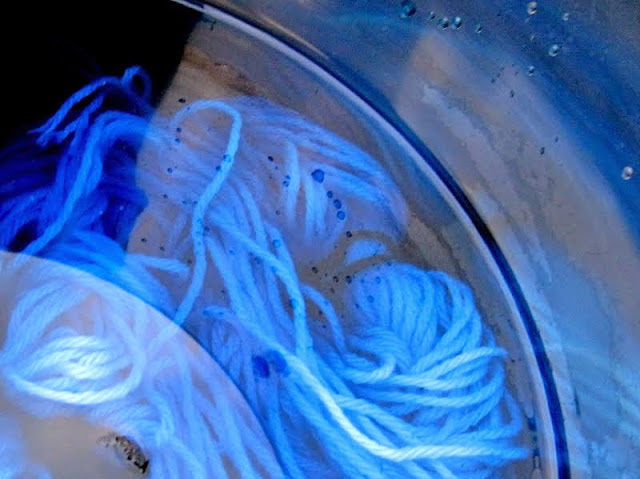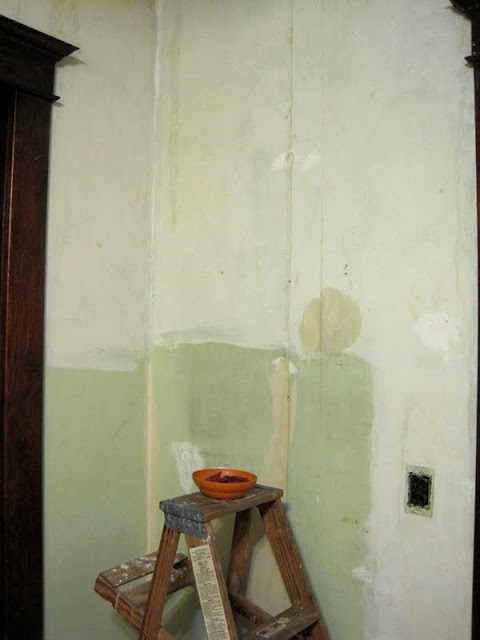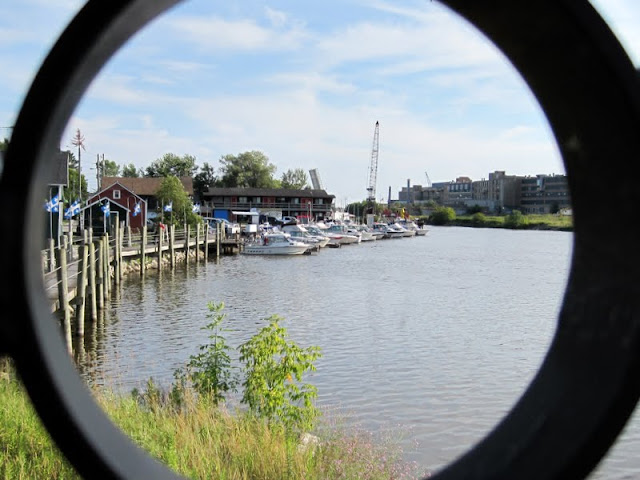Then she makes a few more blocks and joins them into a flowery square:
Then she juggles the block rounds to come up with a lacy version:
Finally she joins the flowery square to the lacy square, adds some straps, a fabric lining, and a bobble-ended tie...
...and she has herself a bag. A Chicory Square bag.
And then, of course, she tries it in a completely different yarn weight, just to see if it works....
It does. :)
~ ~ ~
Chicory Square is a quick, versatile, join-as-you-go block that can be combined in several ways. For a traditional-looking project with a bit of granny appeal, make all 5 pattern rounds. For a very lacy project, leave off the granny cluster rounds and join blocks at Round 3. (You can always use the granny and lacy rounds as a border).
More ideas for variations: try changing colours on every round - or go elegantly monotone by sticking to one colour throughout. Add your own border - the chain loops of Rounds 3 and 5 offer plenty of options for embellishment.
Included below are charts for the Chicory Square block, scalloped border, straps, tie, and assembly instructions for a Chicory Square bag - all followed by a pattern in plain English.
Materials:
Any yarn you like with the appropriate size hook. (For scalloped border, use a hook one size larger than you use for the blocks.)
Worsted Weight yarn will yield a 5-round block approximately 4 3/4" square.
DK weight yarn will yield a 5-round block approximately 3 1/4" square.
Yarns/Hooks I used:
10" Square Bag, 4 blocks on each side: Hand-dyed worsted weight kitchen cotton yarn in 2 shades of chicory, less than 100 yards of each shade; Lily Sugar 'n Cream in Sage Green, 1 skein. Hook size H/8, 5mm for blocks; size I/9 5.5mm for scalloped border.
Small Blocks: Planet Penny Cotton Club Yarn in Jade, Lime, Delphinium, Cornflower, less than 1 skein of each. Hook size D/3, 3.25mm.
Allow more yarn for a larger project.
Chicory Square Charted Pattern
Note to chart readers: I had to invent a few symbols here to make up for a gap in the official lexicon. (CYC, are you listening?) :)
See instructions and photos below charts for special stitch explanations.
(Isn't this a nice chart? I've been playing with some free drawing software and am pretty happy with the results.)
Joined Blocks with Border Chart
Bag Assembly, Strap, and Tie
Chicory Square Crochet Pattern in Plain English (with a Few Helpful Photos)
Special Stitches:
Inverse Slip Stitch (inverse sl st): Holding yarn to front of work, insert hook back to front in indicated st; yarn over and pull through.
Invisible Join: Cut yarn, leaving 3" tail. Gently pull yarn up and out of the stitch. Insert hook back to front of stitch you're connecting to; pull yarn tail through. Working from reverse side, insert hook from bottom to top through all horizontal strands and back loop of final stitch; pull yarn tail down and through. Gently tighten up invisible join to match other stitches in size. Finally, pull yarn tail through at least one vertical bar of next stitch to the right. Click here for an invisible join phototutorial.
Right side facing at all times.
Chain 4; join w/ slip stitch to form ring.
Round 1: Chain 1; single crochet 6 in ring. Join to starting single crochet w/ inverse slip stitch (see Special Stitches above and photo below).
Round 2: Chain 9; inverse slip stitch in same single crochet. First petal made.
(Chain 9, inverse slip stitch in next single crochet, chain 9, inverse slip stitch in same single crochet) 5 times.
Final petal: chain 9, cut yarn and join with invisible join (see Special Stitches above) to first inverse slip stitch at base of first petal. Your flower should now have 12 petals.
Round 3: Attach new yarn with slip stitch (counts as first single crochet) in any petal space.
*(Chain 3, double crochet in back bump of 3rd ch from hook, single crochet in next petal space) twice. Make corner: chain 5, double crochet in back bump of 5th ch from hook, single crochet in next petal space; corner made.*
Repeat from * to * 3 times; join w/ slip stitch to top of slip stitch at beginning of first loop. Chain 4; remove hook and place marker in loop (or draw out a long loop) to keep it "live". Do not cut yarn (unless you plan to make Round 5 a different colour).
Round 4: Attach new yarn with slip stitch (counts as first single crochet) in the next chain-3 space. Chain 2 (counts as first double crochet), double crochet 2 in same space. Make corner in next (should be a chain-5) space: double crochet 3, chain 3, double crochet 3 in chain-5 space; corner made.
*(Double crochet 3 in next chain-3 space) twice across side of square; (double crochet 3, chain 3, double crochet 3) in chain-5 space; corner made.*
Repeat from * to * two more times.
Double crochet 3 in final chain-3 space; cut yarn and join with invisible join to top of first "real" double crochet of round (do not join to starting ch-2).
Round 5: Remove marker if necessary from Round 3 loop, and tighten loop to working size. Gently pull ch-4 across back of granny cluster and to the left, holding ch-4 behind work with your finger. (See chart.) Insert hook from front to back in space between starting and ending granny clusters of previous round, and into live loop; pull loop to front and slip stitch to secure (counts as first single crochet).
Work rest of round same as Round 3, making the single crochets in spaces between granny clusters. Each side should have four (4) ch-3 loops between the ch-5 corner loops. Join final ch-3 loop with invisible join to top of starting slip stitch.
Cut yarn and tie off. Weave in all ends.
Rounds 4 - 5 may be repeated as many times as you like, or used as a border for blocks that have already been joined.
Joining the Blocks:
Join blocks on either Round 3 or Round 5 by replacing the center stitch of each ch-3 or ch-5 loop with a single crochet attached to the matching loop in opposite block.
For side joins: chain 1, single crochet in opposite ch-3 loop (inserting hook as below), chain 1, double crochet in back bump of first chain, single crochet in next space.
For outside corner joins: chain 2, single crochet in opposite ch-5 loop (inserting hook as above), chain 2, double crochet in back bump of first chain, single crochet in same space.
For inside, or 4-corner joins: work the third and fourth joining single crochets into 2 side strands of the original joining single crochet:
To make a bag like mine:
For front, make 4 Chicory Square blocks joined at Round 5. For back, make 4 blocks joined at Round 3, then work Rounds 4-5 twice as a border (this will make front and back the same size).
Scalloped Border for Single or Double Layers (see also chart above):
Increase 1 hook size. Join yarn w/slip stitch in corner space of any block; chain 1. Single crochet 3 in each ch-3 space across and in ch-5 spaces where blocks are joined; single crochet 6 in each outside corner space.
This border will work for any size combination of blocks.
Bag Assembly (see also chart above):
Start in the corner of a single square, RS facing, and work border as above across one side of square. Make 3 single crochets in next corner space. Place wrong sides of squares together, matching loop spaces and corners. Still working in same corner space, turn corner and work 3 single crochets in corner spaces of both front and back layers. Continue working scalloped border, holding front and back pieces together, around 3 sides of bag, ending with 3 single crochets in starting corner space. Turn and work 3 single crochets in corner space and in each space across unfinished (back) layer (WS facing). Finish with 3 single crochets in far corner. Join with invisible join to next single crochet.
Easy Textured Straps (see also chart above):
Leaving 8" tail, chain 3. Half-double crochet 2 together (hdc2tog) in 2nd and 3rd chains from hook. *Chain 2, turn, hdc2tog in 2nd ch from hook and next stitch. Repeat from * to desired strap length (I made my straps as long as one side of the bag - about 10"). Cut yarn and tie off, leaving 8" tail.
Make 2 straps. Use yarn tails to sew to front and back of bag. (You can decide where to attach them - on my bag they were attached to the third scallop in from either edge.)
Optional Tie (see also chart above):
Chain 3; hdc 4 in back loop of 3rd chain from hook. Inverse slip stitch to first hdc; pull yarn tail and working yarn end to tighten bobble. Chain to desired length of tie (mine was about 80 chains). To make finishing bobble, hdc 4 in back loop of 3rd ch from hook. Inverse slip stitch to first hdc; pull yarn to tighten bobble. Cut yarn; insert hook through opposite end of bobble and pull yarn tail through to hide in bobble; carefully trim. Repeat with yarn tail at other end of tie.
Working from outside of bag, thread bobbles through center 2 spaces just below scalloped border, then across open top of bag. From inside, thread through center 2 spaces of front of bag. Tie may be pulled open to access bag, or tied in a bow to keep bag shut.
Line bag as desired and enjoy!
(In my next post, I'll show you how I made a lining, with pocket, for my Chicory Square Bag.)
You are free to do whatever you like with the items you make from this pattern, but you may not sell the pattern or re-post on a different website.
Thanks for viewing, and happy crocheting!
~ ~ ~ ~ ~ ~ ~ ~ ~ ~ ~ ~




































































